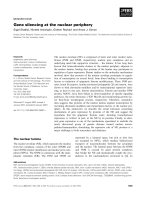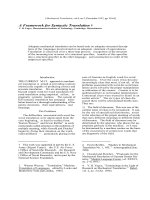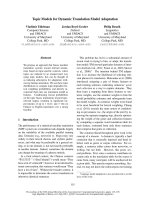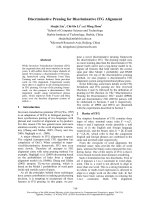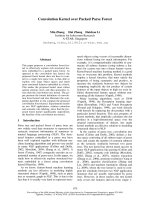Tài liệu Báo cáo khoa học: "HINDI TO PUNJABI MACHINE TRANSLATION SYSTEM" pdf
Bạn đang xem bản rút gọn của tài liệu. Xem và tải ngay bản đầy đủ của tài liệu tại đây (254.08 KB, 6 trang )
Proceedings of the ACL-HLT 2011 System Demonstrations, pages 1–6,
Portland, Oregon, USA, 21 June 2011.
c
2011 Association for Computational Linguistics
HINDI TO PUNJABI MACHINE TRANSLATION
SYSTEM
Vishal Goyal Gurpreet Singh Lehal
Department of Computer Science Department of Computer Science
Punjabi University, Patiala,India Punjabi University, Patiala,India
Abstract
Hindi-Punjabi being closely related language
pair (Goyal V. and Lehal G.S., 2008) , Hybrid
Machine Translation approach has been used
for developing Hindi to Punjabi Machine
Translation System. Non-availability of lexical
resources, spelling variations in the source
language text, source text ambiguous words,
named entity recognition and collocations are
the major challenges faced while developing
this syetm. The key activities involved during
translation process are preprocessing,
translation engine and post processing. Lookup
algorithms,
pattern matching algorithms etc
formed the basis for solving these issues. The
system accuracy has been evaluated using
intelligibility test, accuracy test and BLEU
score. The hybrid syatem is found to perform
better than the constituent systems.
Keywords: Machine Translation, Computational
Linguistics, Natural Language Processing, Hindi,
Punjabi. Translate Hindi to Punjabi, Closely
related languages.
1 Introduction
Machine Translation system is a software
designed that essentially takes a text in one
language (called the source language), and
translates it into another language (called the
target language). There are number of
approaches for MT like Direct based,
Transform based, Interlingua based, Statistical
etc. But the choice of approach depends upon
the available resources and the kind of
languages involved. In general, if the two
languages are structurally similar, in particular
as regards lexical correspondences,
morphology and word order, the case for
abstract syntactic analysis seems less
convincing. Since the present research work
deals with a pair of closely related language
i.e. Hindi-Punjabi , thus direct word-to-word
translation approach is the obvious choice. As
some rule based approach has also been used,
thus, Hybrid approach has been adopted for
developing the system. An exhaustive survey
has already been given for existing machine
translations systems developed so far
mentioning their accuracies and limitations.
(Goyal V. and Lehal G.S., 2009).
2 System Architecture
2.1 Pre Processing Phase
The preprocessing stage is a collection of
operations that are applied on input data to
make it processable by the translation engine.
In the first phase of Machine Translation
system, various activities incorporated include
text normalization, replacing collocations and
replacing proper nouns.
2.2 Text Normalization
The variety in the alphabet, different dialects
and influence of foreign languages has resulted
in spelling variations of the same word. Such
variations sometimes can be treated as errors in
writing. (Goyal V. and Lehal G.S., 2010).
2.3 Replacing Collocations
After passing the input text through text
normalization, the text passes through this
Collocation replacement sub phase of Pre-
processing phase. Collocation is two or more
consecutive words with a special behavior.
(Choueka :1988). For example, the collocation
उर देश (uttar pradēsh) if translated word to
word, will be translated as ਜਵਾਬ ਰਾਜ (javāb rāj)
but it must be translated as ਉਤਰ ਪਦੇਸ਼ (uttar
pradēsh). The accuracy of the results for
collocation extraction using t-test is not
accurate and includes number of such bigrams
and trigrams that are not actually collocations.
Thus, manually such entries were removed and
actual collocations were further extracted. The
1
Post Processing
Translation Engine
Pre Processing
1. Identifying Surnames
2. Identifying Titles
3. Hindi Morph Analyzer
4. Lexicon Lookup
5. Ambiguity Resolution
6. Handling Unkown Words
Text Normalization
Replacing Proper Nouns
Replacing Collocations
A
g
reement
Tokenizer
Token Analyzer
Pun
j
abi Text
correct corresponding Punjabi translation for
each extracted collocation is stored in the
collocation table of the database. The
collocation table of the database consists of
5000 such entries. In this sub phase, the
normalized input text is analyzed. Each
collocation in the database found in the input
text will be replaced with the Punjabi
translation of the corresponding collocation. It
is found that when tested on a corpus
containing about 1,00,000 words, only 0.001%
collocations were found and replaced during
the translation.
Hindi Text
Figure 1 : Overview of Hindi-Punjabi Machine Translation System
2.4 Replacing Proper Nouns
A great proposition of unseen words includes
proper nouns like personal, days of month,
days of week, country names, city names, bank
names, organization names, ocean names, river
names, university names etc. and if translated
word to word, their meaning is changed. If the
meaning is not affected, even though this step
fastens the translation process. Once these
words are recognized and stored into the
proper noun database, there is no need to
decide about their translation or transliteration
every time in the case of presence of such
words in input text for translation. This
gazetteer makes the translation accurate and
fast. This list is self growing during each
Collocations database
Pro
p
er Nouns database
Proper Noun
recognition Rules
Surnames database
Surnanes recognition
Rules
Titles database
Titles recognition
Rules
Hindi Morphological
Rules
Hindi-Pun
j
abi Root Words
Bi
g
rams and Tri
g
rams
Ambi
g
uos Words
Transliteration Rules
Transliteration Ma
pp
in
g
s
Text Normalization Rules
Agreement Rules
2
translation. Thus, to process this sub phase, the
system requires a proper noun gazetteer that
has been complied offline. For this task, we
have developed an offline module to extract
proper nouns from the corpus based on some
rules. Also, Named Entity recognition module
has been developed based on the CRF
approach (Sharma R. and Goyal V., 2011b).
2.5 Tokenizer
Tokenizers (also known as lexical analyzers or
word segmenters) segment a stream of
characters into meaningful units called tokens.
The tokenizer takes the text generated by pre
processing phase as input. Individual words or
tokens are extracted and processed to generate
its equivalent in the target language. This
module, using space, a punctuation mark, as
delimiter, extracts tokens (word) one by one
from the text and gives it to translation engine
for analysis till the complete input text is read
and processed.
2.6 Translation Engine
The translation engine is the main component
of our Machine Translation system. It takes
token generated by the tokenizer as input and
outputs the translated token in the target
language. These translated tokens are
concatenated one after another along with the
delimiter. Modules included in this phase are
explained below one by one.
2.6.1 Identifying Titles and Surnames
Title may be defined as a formal appellation
attached to the name of a person or family by
virtue of office, rank, hereditary privilege,
noble birth, or attainment or used as a mark of
respect. Thus word next to title and word
previous to surname is usually a proper noun.
And sometimes, a word used as proper name
of a person has its own meaning in target
language. Similarly, Surname may be defined
as a name shared in common to identify the
members of a family, as distinguished from
each member's given name. It is also called
family name or last name. When either title or
surname is passed through the translation
engine, it is translated by the system. This
cause the system failure as these proper names
should be transliterated instead of translation.
For example consider the Hindi sentence
ीमान हष जी हमारे यहाँ पधारे। (shrīmān harsh jī
hamārē yahā
ṃ
padhārē). In this sentence, हष
(harsh) has the meaning “joy”. The equivalent
translation of हष (harsh) in target language is
ਖੁਸ਼ੀ (khushī). Similarly, consider the Hindi
sentence काश सह हमारे यहाँ पधारे।. (prakāsh
si
ṃ
h hamārē yahā
ṃ
padhārē). Here, काश
(prakāsh) word is acting as proper noun and it
must be transliterated and not translated
because सह (si
ṃ
h) is surname and word
previous to it is proper noun.
Thus, a small module has been developed for
locating such proper nouns to consider them as
title or surname. There is one special character
‘॰’ in Devanagari script to mark the symbols
like डा॰, ो॰. If this module found this symbol
to be title or surname, the word next and
previous to this token as the case may be for
title or surname respectively, will be
transliterated not translated. The title and
surname database consists of 14 and 654
entries respectively. These databases can be
extended at any time to allow new titles and
surnames to be added. This module was tested
on a large Hindi corpus and showed that about
2-5 % text of the input text depending upon its
domain is proper noun. Thus, this module
plays an important role in translation.
2.6.2 Hindi Morphological analyzer
This module finds the root word for the token
and its morphological features.Morphological
analyzer developed by IIT-H has been ported
for Windows platform for making it usable for
this system. (Goyal V. and Lehal G.S.,2008a)
2.6.3 Word-to-Word translation using
lexicon lookup
If token is not a title or a surname, it is looked
up in the HPDictionary database containing
Hindi to Punjabi direct word to word
translation. If it is found, it is used for
translation. If no entry is found in
HPDictionary database, it is sent to next sub
phase for processing. The HPDictionary
database consists of 54,127 entries.This
database can be extended at any time to allow
new entries in the dictionary to be added.
2.6.4 Resolving Ambiguity
3
Among number of approaches for
disambiguation, the most appropriate approach
to determine the correct meaning of a Hindi
word in a particular usage for our Machine
Translation system is to examine its context
using N-gram approach. After analyzing the
past experiences of various authors, we have
chosen the value of n to be 3 and 2 i.e. trigram
and bigram approaches respectively for our
system. Trigrams are further categorized into
three different types. First category of trigram
consists of context one word previous to and
one word next to the ambiguous word. Second
category of trigram consists of context of two
adjacent previous words to the ambiguous
word. Third category of the trigram consists of
context of two adjacent next words to the
ambiguous word. Bigrams are also categorized
into two categories. First category of the
bigrams consists of context of one previous
word to ambiguous word and second category
of the bigrams consists of one context word
next to ambiguous word. For this purpose, the
Hindi corpus consisting of about 2 million
words was collected from different sources
like online newspaper daily news, blogs, Prem
Chand stories, Yashwant jain stories, articles
etc. The most common list of ambiguous
words was found. We have found a list of 75
ambiguous words out of which the most
frequent are से sē and और aur. (Goyal V. and
Lehal G.S., 2011)
2.6.5 Handling Unknown Words
2.6.5.1 Word Inflectional Analysis and
generation
In linguistics, a suffix (also sometimes called a
postfix or ending) is an affix which is placed
after the stem of a word. Common examples
are case endings, which indicate the
grammatical case of nouns or adjectives, and
verb endings. Hindi is a (relatively) free word-
order and highly inflectional language.
Because of same origin, both languages have
very similar structure and grammar. The
difference is only in words and in
pronunciation e.g. in Hindi it is लड़का and in
Punjabi the word for boy is ਮੁੰਡਾ and even
sometimes that is also not there like घर (ghar)
and ਘਰ (ghar). The inflection forms of both
these words in Hindi and Punjabi are also
similar. In this activity, inflectional analysis
without using morphology has been performed
for all those tokens that are not processed by
morphological analysis module. Thus, for
performing inflectional analysis, rule based
approach has been followed. When the token is
passed to this sub phase for inflectional
analysis, If any pattern of the regular
expression (inflection rule) matches with this
token, that rule is applied on the token and its
equivalent translation in Punjabi is generated
based on the matched rule(s). There is also a
check on the generated word for its
correctness. We are using correct Punjabi
words database for testing the correctness of
the generated word.
2.6.5.2 Transliteration
This module is beneficial for handling out-of-
vocabulary words. For example the word
िवशाल (vishāl) is transliterated as ਿਵਸ਼ਾਲ
(vishāl) whereas translated as ਵੱਡਾ. There must
be some method in every Machine Translation
system for words like technical terms and
proper names of persons, places, objects etc.
that cannot be found in translation resources
such as Hindi-Punjabi bilingual dictionary,
surnames database, titles database etc and
transliteration is an obvious choice for such
words. (Goyal V. and Lehal G.S., 2009a).
2.7 Post-Processing
2.7.1 Agreement Corrections
In spite of the great similarity between Hindi
and Punjabi, there are still a number of
important agreement divergences in gender
and number. The output generated by the
translation engine phase becomes the input for
post-processing phase. This phase will correct
the agreement errors based on the rules
implemented in the form of regular
expressions. (Goyal V. and Lehal G.S., 2011)
3 Evaluation and Results
The evaluation document set consisted of
documents from various online newspapers
news, articles, blogs, biographies etc. This test
bed consisted of 35500 words and was
translated using our Machine Translation
system.
3.1 Test Document
4
For our Machine Translation system
evaluation, we have used benchmark sampling
method for selecting the set of sentences. Input
sentences are selected from randomly selected
news (sports, politics, world, regional,
entertainment, travel etc.), articles (published
by various writers, philosophers etc.), literature
(stories by Prem Chand, Yashwant jain etc.),
Official language for office letters (The
Language Officially used on the files in
Government offices) and blogs (Posted by
general public in forums etc.). Care has been
taken to ensure that sentences use a variety of
constructs. All possible constructs including
simple as well as complex ones are
incorporated in the set. The sentence set also
contains all types of sentences such as
declarative, interrogative, imperative and
exclamatory. Sentence length is not restricted
although care has been taken that single
sentences do not become too long. Following
table shows the test data set:
Table 1: Test data set for the evaluation of
Hindi to Punjabi Machine Translation
System
Daily
News
Articles
Official
Language
Quotes
Blog
Literature
Total
Documents
100 50 01 50 20
Total
Sentences
10,000 3,500 8,595 3,300 10,045
Total
Words
93,400 21,674 36,431 15,650 95,580
3.2 Experiments
It is also important to choose appropriate
evaluators for our experiments. Thus,
depending upon the requirements and need of
the above mentioned tests, 50 People of
different professions were selected for
performing experiments. 20 Persons were from
villages that only knew Punjabi and did not
know Hindi and 30 persons were from
different professions having knowledge of both
Hindi and Punjabi. Average ratings for the
sentences of the individual translations were
then summed up (separately according to
intelligibility and accuracy) to get the average
scores. Percentage of accurate sentences and
intelligent sentences was also calculated
separately by counting the number of
sentences.
3.2.1 Intelligibility Evaluation
The evaluators do not have any clue about the
source language i.e. Hindi. They judge each
sentence (in target language i.e. Punjabi) on
the basis of its comprehensibility. The target
user is a layman who is interested only in the
comprehensibility of translations. Intelligibility
is effected by grammatical errors, mis-
translations, and un-translated words.
3.2.1.1 Results
The response by the evaluators were analysed
and following are the results:
• 70.3 % sentences got the score 3 i.e. they
were perfectly clear and intelligible.
• 25.1 % sentences got the score 2 i.e. they
were generally clear and intelligible.
• 3.5 % sentences got the score 1 i.e. they were
hard to understand.
• 1.1 % sentences got the score 0 i.e. they were
not understandable.
So we can say that about 95.40 % sentences
are intelligible. These sentences are those
which have score 2 or above. Thus, we can say
that the direct approach can translate Hindi text
to Punjabi Text with a consideably good
accuracy.
3.2.2 Accuracy Evaluation / Fidelity
Measure
The evaluators are provided with source text
along with translated text. A highly intelligible
output sentence need not be a correct
translation of the source sentence. It is
important to check whether the meaning of the
source language sentence is preserved in the
translation. This property is called accuracy.
3.2.2.1 Results
Initially Null Hypothesis is assumed i.e. the
system’s performance is NULL. The author
assumes that system is dumb and does not
produce any valuable output. By the
intelligibility of the analysis and Accuracy
analysis, it has been proved wrong.
The accuracy percentage for the system is
found out to be 87.60%
Further investigations reveal that out of
13.40%:
• 80.6 % sentences achieve a match
between 50 to 99%
• 17.2 % of remaining sentences were
marked with less than 50% match
against the correct sentences.
5
• Only 2.2 % sentences are those which
are found unfaithful.
A match of lower 50% does not mean that the
sentences are not usable. After some post
editing, they can fit properly in the translated
text. (Goyal, V., Lehal, G.S., 2009b)
3.2.2 BLEU Score:
As there is no Hindi –Parallel Corpus was
available, thus for testing the system
automatically, we generated Hindi-Parallel
Corpus of about 10K Sentences. The BLEU
score comes out to be 0.7801.
5 Conclusion
In this paper, a hybrid translation approach
for translating the text from Hindi to
Punjabi has been presented. The proposed
architecture has shown extremely good
results and if found to be appropriate for
MT systems between closely related
language pairs.
Copyright
The developed system has already been
copyrighted with The Registrar, Punjabi University,
Patiala with authors same as the authors of the
publication.
Acknowlegement
We are thankful to Dr. Amba Kulkarni, University
of Hyderabad for her support in providing technical
assistance for developing this system.
References
Bharati, Akshar, Chaitanya, Vineet, Kulkarni,
Amba P., Sangal, Rajeev. 1997. Anusaaraka:
Machine Translation in stages. Vivek, A Quarterly
in Artificial Intelligence, Vol. 10, No. 3. ,NCST,
Banglore. India, pp. 22-25.
Goyal V., Lehal G.S. 2008. Comparative Study of
Hindi and Punjabi Language Scripts, Napalese
Linguistics, Journal of the Linguistics Society of
Nepal, Volume 23, November Issue, pp 67-82.
Goyal V., Lehal, G. S. 2008a. Hindi Morphological
Analyzer and Generator. In Proc.: 1
st
International
Conference on Emerging Trends in Engineering
and Technology, Nagpur, G.H.Raisoni College of
Engineering, Nagpur, July16-19, 2008, pp. 1156-
1159, IEEE Computer Society Press, California,
USA.
Goyal V., Lehal G.S. 2009. Advances in Machine
Translation Systems, Language In India, Volume 9,
November Issue, pp. 138-150.
Goyal V., Lehal G.S. 2009a. A Machine
Transliteration System for Machine Translation
System: An Application on Hindi-Punjabi
Language Pair. Atti Della Fondazione Giorgio
Ronchi (Italy), Volume LXIV, No. 1, pp. 27-35.
Goyal V., Lehal G.S. 2009b. Evaluation of Hindi to
Punjabi Machine Translation System. International
Journal of Computer Science Issues, France, Vol. 4,
No. 1, pp. 36-39.
Goyal V., Lehal G.S. 2010. Automatic Spelling
Standardization for Hindi Text. In : 1
st
International
Conference on Computer & Communication
Technology, Moti Lal Nehru National Institute of
technology, Allhabad, Sepetember 17-19, 2010, pp.
764-767, IEEE Computer Society Press, California.
Goyal V., Lehal G.S. 2011. N-Grams Based Word
Sense Disambiguation: A Case Study of Hindi to
Punjabi Machine Translation System. International
Journal of Translation. (Accepted, In Print).
Goyal V., Lehal G.S. 2011a. Hindi to Punjabi
Machine Translation System. In Proc.: International
Conference for Information Systems for Indian
Languages, Department of Computer Science,
Punjabi University, Patiala, March 9-11, 2011, pp.
236-241, Springer CCIS 139, Germany.
Sharma R., Goyal V. 2011b. Named Entity
Recognition Systems for Hindi using CRF
Approach. In Proc.: International Conference for
Information Systems for Indian Languages,
Department of Computer Science, Punjabi
University, Patiala, March 9-11, 2011, pp. 31-35,
Springer CCIS 139, Germany.
6

